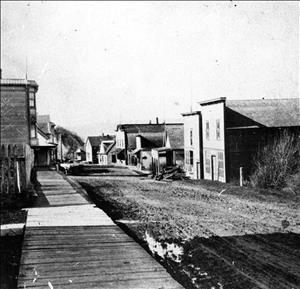On Saturday April 2, 1910, one of Washington’s oldest towns, Coupeville -- situated on Penn Cove, central Whidbey Island -- holds an election to decide on city incorporation. Citizens approve the measure and elect a mayor and council who begin to face the challenges posed by a population boom initiated by activation of Fort Casey in 1901. Official incorporation makes Coupeville a city of the fourth class.
Incorporating Coupeville
The opening of Fort Casey near Ebey’s Landing in 1901 quickly added a floating population of more than 300 men to Central Whidbey Island, greatly impacting the nearest town, Coupeville, with its small population of 310 citizens living on 250 acres of land. Coupeville residents began to push for needed city incorporation. Roads and utilities were needed as well as police and fire services. And in the economic boom the Pacific Northwest was experiencing in the first decade of the twentieth century, Whidbey Island residents expected further growth.
In February 1910 the Island County Board of Commissioners called for a vote on Coupeville incorporation and town boundaries were accepted according to a previously filed town plat. Thomas and Maria Coupe’s property (settled on in 1852 and filed officially as a Donation Land Claim in 1854) formed the eastern portion of the town, with settler John Alexander’s property making up the western portion.
Not all residents were supportive, some fearing that incorporation would annex good farmland and lead to higher taxes. But on April 2, 1910, Coupeville residents voted 41 to 36 to incorporate and approved a roster of candidates. Charles H. Lyon (b. 1862) was elected as mayor, with J. Straub, A. D. Hallock, Albert R. Kineth, Edward O. Lovejoy, and H. W. Libbey chosen as councilmen. J. C. Richards was selected to be town clerk and J. H. Parker chosen town marshal and street commissioner.
Articles of Incorporation were filed with Island County commissioners on April 4 and with the state of Washington on April 13, 1910. (Coupeville’s incorporation date is often shown as April 20th or April 25th.) The town’s
first council meeting was held on April 26, and the council decided to meet on the second and fourth Tuesday of each month in the northwest room of the J. T. Wanamaker house on Coupeville’s Front Street. A rental price of $1 per meeting was set, with the understanding that if and when the Wanamaker’s rented the house, council would seek other quarters. W. D. Craddock became town attorney and lawyer A. N. Corbin was chosen to draw up 25 ordinances and given the choice of being paid $2 per ordinance or working for $25 a month. Council records show that Corbin chose the $25 salary.
From Streets to Taxes to Dogs and Mules
Committees were formed to begin plans for streets and sidewalks, a water works and electric lights, police registration, and auditing. Bids were received for construction of utilities, one from Councilman Lovejoy and two from the construction firm owner Ira Todd. One of the Todd petitions was accepted, leading Lovejoy to resign as councilman. He was replaced by Chris Solid.
In May city council designated the Island County Times as the official town newspaper and Elias Vrandenberg as police judge. Ordinance No. 3 required dog licenses and authorized the town marshal to destroy loose dogs. Ordinance No. 7 taxed peddlers, those on foot at a rate of $5 per day and those operating with a buggy or another conveyance at $10 per day.
In June council approved a street poll tax; prohibited drunkenness and loud, boisterous language and conduct; made regulations applying to the collection of taxes; formed the office of pound master to prohibit horses, cattle, and mules from running at large on the streets. The town marshal’s salary was set and an ordinance passed that prohibited the butchering, killing, and slaughtering of hogs, cattle, and sheep within the city limits. Street commissioner Parker was given his first task, raking the rocks out of Coupeville’s Main Street.
By the end of 1911, Coupeville had telephones and street lights.

